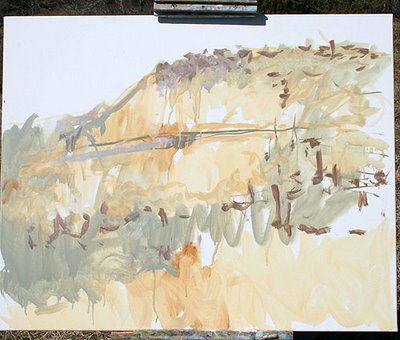Ébauche or Lay-ins in Plein-Air ‘Alla Prima’ Oil Painting
Large size Oil on Canvas
81 x 65 cm (approx 32 x 26 inches)
© The Artist.

Work in Progress (WIP) – lay in stage two
Large size Oil on Canvas
81 x 65 cm (approx 32 x 26 inches)
© The Artist.

Example of a lay-in prioritising line
Paul Cézanne
Paul Cézanne left a lot of ‘unfinished’ paintings ? weither they were abandoned or left aside or just never pushed to resolution or abandoned in a state of despiar by the artist we will never realyy know. His diaries tell us not. However these half-finished paintings are a great testimony to his working process. They taught me to paint in oils, simply put. I used to spend hours looking at them in wonder. Looking for clues too. What a great gift he left to us artists who follow behind.
A lay-in has alot of painterly charm because at this stage, you aren’t concerned with descriptive details & little, fiddly fine brush work. You are roughing-in the overall masses.
A lay-in in oil should follow the ‘fat over lean’ rule (thick paint over thin paint). Note how diluted with turps the paint is (a great advantage of plein-air is that the artist isn’t intoxicated with fumes whilst shut-up in an atelier).
For this large size painting, working quickly with the changing light en plein-air, the surface was fairly quickly covered with the intial lay-in.
The lay-in phase comes after the conception phase (where you have the idea or see the painting in your mind’s eye) & the composition stage (where you work out what goes where & how if fits together).
I find that getting the major relationships between the colours painted early on in the lay-in stage is essential to how a painting fits together as a whole, as a set of harmonics. It also estabilshes the quality of the light, the timbre & feel of the place. Getting this clear early on speeds up the painting process, which in plein-air painting can be something of a race against the sun’s movement… if I had a euro for every time I’ve heard ” the light’s changed”.
In a lay-in, you kind of bring the whole painting-up at the same time all together, rather than finishing a bit here then finishing another over there (as much as is possible). Try & keep an eye on how the whole fits together. For such large oil paintings, done in one session ‘alla prima’ en plein-air, on location, on the spot, you really do need to have an idea of how the painting will/might unfold.
NOTE : Not every painting unfolds in the same way. Just as in cooking, different meals, different recipes require different approaches.
![[karst500.jpg]](https://4.bp.blogspot.com/_weTiHwuZsVo/ScO9jsNwZtI/AAAAAAAACMM/l-hVFylJmjc/s1600/karst500.jpg)
‘Karst Landscape’ – unfinished state
Large Oil on Canvas
81 x 65 cm (approx 32 x 26 inches)
© The Artist



